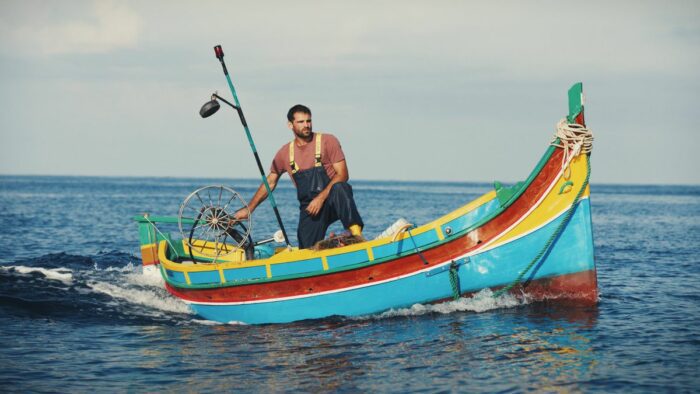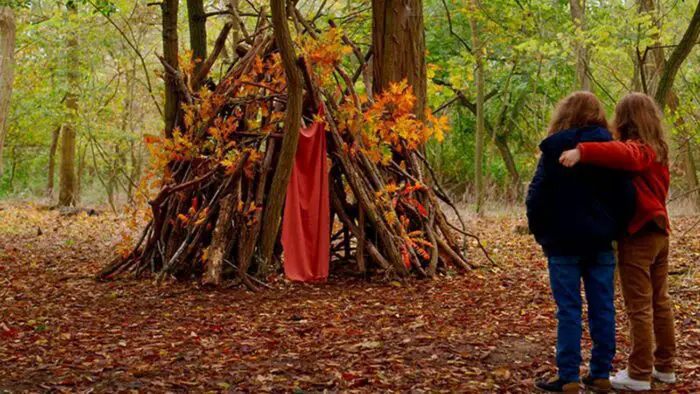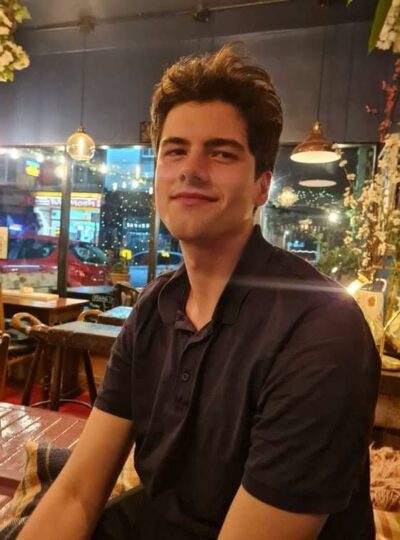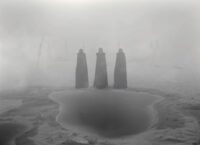This article is part of a series of pieces covering the releases of the 2021 BFI London Film Festival; earlier entries in this series are available on the site.
Luzzu

Aside from the question, “what the heck is a Luzzu?” the shadow looming largest over Alex Camilleri’s feature film directing debut Luzzu is the preexistence of two prior features, each in their own way a masterpiece. Those films are Bicycle Thieves, Vittorio de Sica’s seminal portrait of postwar poverty and desperation—an indisputable landmark in world cinema—and Bait, Mark Jenkin’s extraordinary feature following the impact of gentrification on a small fishing village as an embittered local fisherman chafes against the interloping tourists. These two films came to mind so frequently while watching Luzzu that they became an inescapable yardstick against which I started to measure the film. As these are two of the best films ever made, that wasn’t terribly fair to Luzzu (plus, as a vegetarian, my sympathies for a person who kills wild animals for a living only runs so deep). Increasingly though, I found myself looking more charitably at it as, viewed more in isolation, it’s a deeply touching and despondently angry film with a lot of complexity to it.
The film follows Jesmark (played by non-professional actor Jesmark Scicluna), a new father who is struggling under the heel of intractable EU fishing quotas—quotas that mean they’re throwing back as much as they’re earning—and struggling to make ends meet. The titular luzzu is in fact a type of brightly coloured skiff used by Maltese fishermen for centuries, but which no longer cut the mustard against the big trawlers churning up the seabed and choking the life out of the industry.
One could be forgiven for assuming that forcing out small independent fishermen like Jesmark and fortifying the position of environmentally and economically harmful trawling monopolies was hardly an unintended consequence of these fishing quotas. For his part, Jesmark would sooner turn to crime than a trawling company. So that’s what he does, resorting to side hustles to keep his family business alive, soon finding there’s good money to be made recovering and selling the fish it was illegal to have caught.
Like Bait, the film is as much about the personal struggles of its lead as it is their economic situation—it’s firmly established how many less romantic alternatives Jesmark has. Jesmark’s attachment to his life is more sentimental than moral or financial; his wife’s family are well off and he bridles at their incessant undermining, desperate to prove to them, and to himself, that there’s still a place for him and his grandfather’s Luzzu in the callous modern economy.
His attachment to the craft is understandable; it’s a beautiful thing, a glittering emblem of a lost epoch of craftspeople, when beauty, functionality and durability went hand in hand and weren’t all subsumed by “profitability”. Luzzus each have a pair of eyes painted on their prow, an anthropomorphic touch that allows Jes’s forefathers to bear witness to his defeat, a blunt piece of symbolism that works, despite its heavy-handedness.
However, as often as it might appear like it, Luzzu is no regressive paean to a romanticised past glory. Rather, it’s a sharp and comprehensive look at a situation from all sides, seeing how a community is shaped by the decrees of our so-called leaders and who benefits from such change. Who will be the opportunists to make their hay before the fields dry up forever, and who will cling to their principles and go under?
You can somewhat tell that Scicluna is not an actor by trade; unlike De Scia, I don’t think Camilleri discovered one of those great non-professionals who outshine the most practiced of peers. A different performer could have elevated the film rather than merely held it together, though his brooding, misty-eyed squint has some mileage to it. The script too has sufficient credibility to it to infect the viewer with its economic outrage.
The third act is beautifully touching and bittersweet (though with greater emphasis on the bitterness) as Jesmark finally begins to let go of the past for the sake of his son, his duty to whom is inevitably greater than his duty to his forefathers. It’s a poignant and bitter drama of the changing times: the loss of the romanticised past and the forging of a colder, more pragmatic and inevitably darker future.
Petite Maman

One of the most anticipated films of my year, Celine Sciamma‘s follow up to what may likely go down in history as her magnum opus (not to mention one of the most important films of the decade), Petite Maman is a much smaller and less challenging film than Portrait of a Lady on Fire, but little the worse for it. The film returns Sciamma to the subject of childhood, which she showed such a deft and uncondescending touch with in her earlier films like Water Lilies, Tomboy, My Life as a Courgette and Girlhood. Although one can detect authorial continuity between those films and this, Petite Maman is surprisingly 100% Studio Ghibli, with the tender, sentimental and dreamlike spirit of When Marnie Was There very much alive in it.
The film follows the lonely eight-year-old Nelly (Josephine Sanz) as she is brought to her mother’s childhood home while her parents (Nina Meunisse and Stephane Varupenne) pack away her late grandmother’s effects. However, Nelly’s depressive mother finds herself unable to cope with the process and has to leave to collect herself, but as Nelly explores the woods behind the house, something magical begins to take place to bring mother and daughter together.
While wandering in her own hundred-acre wood, Nelly encounters another young girl, Marion (Gabrielle Sanz) building a den out of wood and strikes up a friendship. Josephine and Gabrielle have the easy chemistry of siblings and Sciamma cultivates their connection magnificently, with an infinitely wholesome script and extraordinarily subtle use of editing shots to create a seamless slippage through the years, with some of the most precise, sleight of hand scene transitions I’ve ever seen. From the start, Nelly longs to be closer to her mother and the film establishes her loneliness through some incredibly subtle gestures and dialogue cues. The film is so simple; it doesn’t waste a single line or frame, it’s all alive with meaning and feeling, revealing hidden depths the further you go.
While Portrait of Lady on Fire could occasionally be quite cold and brittle, this is a warm, funny and playful film; a film for the last days of summer stolen from autumn’s grasp, a moment lost in time, defined both by its transitiveness and its evocative realness. It’s a gentle and touching tale of intergenerational bonding as mother and daughter come to know one another in much the same way as the protagonists of Memory Box did—the two would even make effective sister films, though I think this is by far the better of the two, as Sciamma’s grasp of childhood is as assured and mature as ever, depicting her subjects with rare respect, honesty and gentle tact. Petite Maman feels genuinely magical, all the more so for its organic quality and lightness of touch.
Lamb

I wish distributors would stop marketing non-horror films as horror. If Lamb is a horror film then it’s the least scary horror film I’ve ever seen. It’s swiftly accrued a reputation as one of the strangest and most divisive films of the year, and I think that has a lot to do with the fact it’s genre-labelled as a horror film, setting audiences up for disappointment. Even if they acclimatise themselves to what it really is, it still won’t be what they wanted or expected when they went in. Lamb is not a horror film. It does use macabre imagery and ideas to explore themes of the return of the repressed, which would usually define a film as horror, but given that horror means “a scary movie” to most audiences, then I think we can emphatically state that Lamb is not a horror because it never tries to frighten or disturb the viewer nor escalate tension. If anyone tried to argue that Lamb was a horror film, I’d have to assume they were doing so in order to disparage the film for not being scary enough. What horror elements the film does have would be better left as a surprise.
That does leave one with the question of, what is Lamb if not horror? It’s certainly folkloric and the horror movie could well be described as our modern cautionary folklore, which I’d say Lamb was, but the range of somatic responses the film inspires are entirely different and far, far subtler. It’s a slow burn, no doubt, and frankly, I’ve had enough of them lately. The film’s opening resembles an Icelandic landlocked Jaws as, in POV, some kind of beast roams the countryside, scattering wild ponies like schools of fish, before arriving at Maria (Noomi Rapace) and Ingvar’s (Hilmir Sraer Gudnason) sheep pen. Months later, the childless couple is shocked (though perhaps less shocked than most would be) when one of their ewes births a healthy, but unusual, lamb.
There’s very little conversation between the two about their decision to keep the lamb and raise it indoors, leaving the audience to have those conversations with themselves while watching. There’s obvious parallels to the virgin birth and other biblical references, although calling the mother Maria and having Ingvar pass his time with carpentry is perhaps a little on the nose. Perhaps there’s more of Rosemary’s Baby to this virgin birth though. They name the creature Ada and start raising it as a child, but Ada’s birth mother wants her daughter back. Fantastic acting on the part of that sheep, by the way, I think I saw actual tears! Ada, meanwhile, was never a convincing effect, looking like one of those misbegotten live-action Disney remakes, and is certainly never a credible presence.
Things are further complicated by the arrival of Petur (Bjorn Hignar Sigurdsson), Ingvar’s brother, who has a thing for Maria and gets stranded out by their farm. The arrival of Petur serves little other use than padding, and the film would’ve been a lot more interesting has Ingvar fulfilled this role himself, making the film more compact and intense. The only scary thing ever onscreen in Lamb is Noomi Rapace as the obsessive and possessive Maria. There’s a little of The Shining in this isolated little family—there’s even a locking someone in the pantry scene—but it stays at the early rumblings period for the whole of its runtime, never ratcheting up any intensity or interest. Bear in mind, that’s not a criticism to do with it not being horrific enough, but all movies need to be interesting. The landscape is often spectacular under the perpetual arctic sun, particularly the marshes, and Rapace gives a strong performance, even though I still say the sheep is the standout.
There are some perceptible themes to Lamb, which plays out as a cautionary tale about trying to domesticate nature, but it feels more like a short film or else just an unfinished idea. It’s an admirably ambitious idea and somewhat an entertaining one, but not a coherent one. It feels unfocused and ill-disciplined, with an undercooked script in dire need of doctoring. The film stakes a lot of its interest on the titular creature and once the shock wears off, it’s more distracting than anything. It’s consistently intriguing and thankfully doesn’t drag itself out so long that it outlasts that interest (looking at you Midsommar), but it doesn’t ever develop its ideas and instead comes accross just like an unfinished story outline more than a completed script.



